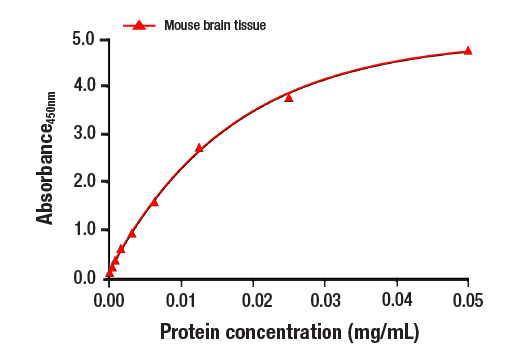| Product Includes | Product # | Quantity | Color | Storage Temp |
|---|---|---|---|---|
| Tau Rabbit mAb Coated Microwells | 47827 | 96 tests |
|
+4C |
| Tau 4R Rabbit Detection mAb | 66222 | 1 ea |
|
+4C |
| HRP Diluent | 13515 | 5.5 ml |
|
+4C |
| TMB Substrate | 7004 | 11 ml |
|
+4C |
| STOP Solution | 7002 | 11 ml |
|
+4C |
| Sealing Tape | 54503 | 2 ea |
|
+4C |
| ELISA Wash Buffer (20X) | 9801 | 25 ml |
|
+4C |
| Cell Lysis Buffer (10X) | 9803 | 15 ml |
|
-20C |
*The microwell plate is supplied as 12 8-well modules - Each module is designed to break apart for 8 tests.
Description
The rapid protocol (RP) PathScan® RP Tau 4R Sandwich ELISA Kit is a solid phase sandwich enzyme-linked immunosorbent assay (ELISA) that detects endogenous levels of Tau 4R protein (Tau 4R iso6/iso7/iso8) in a reduced assay time of 1.5 hours. Incubation of cell lysates and detection antibody on the coated microwell plate forms a sandwich with Tau 4R protein in a single step. The plate is then extensively washed and TMB reagent is added for signal development. The magnitude of absorbance for the developed color is proportional to the quantity of Tau 4R protein. Learn more about all of your ELISA kit options here.
*Antibodies in this kit are custom formulations specific to kit.
Specificity/Sensitivity
Background
Tau is a heterogeneous microtubule-associated protein that promotes and stabilizes microtubule assembly, especially in axons. Six isoforms with different amino-terminal inserts and different numbers of tandem repeats near the carboxy terminus have been identified, and tau is hyperphosphorylated at approximately 25 sites by Erk, glycogen synthase kinase-3 (GSK-3), and CDK5 (1,2). Phosphorylation decreases the ability of tau to bind to microtubules. Neurofibrillary tangles are a major hallmark of Alzheimer's disease (AD); these tangles are bundles of paired helical filaments (PHFs) composed of hyperphosphorylated tau. In particular, phosphorylation at Ser396 by GSK-3 or CDK5 destabilizes microtubules. Furthermore, research studies have shown that inclusions of tau are found in a number of other neurodegenerative diseases, collectively known as tauopathies (1,3).
Alternative splicing of exon 10 results in the expression of two groups of tau; three-repeat and four-repeat tau. Isoforms 2, 4, and 5 express three microtubule binding repeat domains (Tau 3R) while isoforms 6, 7, and 8 express four microtubule binding repeat domains (Tau 4R) (4). The localization of Tau 3R and Tau 4R in cells can be expressed differently in mild or pathological conditions, including Tau 3R in Pick's disease (PiD) and corticobasal degeneration (CBD), while in Alzheimer's disease equally expresses both Tau 3R and Tau 4R (5,6). The repeat-dependent tau has a different pattern of phosphorylation in different diseases, and also has the ability and patterns of aggregation (7-9).
- Johnson, G.V. and Stoothoff, W.H. (2004) J Cell Sci 117, 5721-9.
- Hanger, D.P. et al. (1998) J Neurochem 71, 2465-76.
- Bramblett, G.T. et al. (1993) Neuron 10, 1089-99.
- Šimić, G. et al. (2016) Biomolecules 6, 6.
- Tuerde, D. et al. (2018) J Biol Chem 293, 1781-1793.
- Liu, C. and Götz, J. (2013) PLoS One 8, e84849.
- Weismiller, H.A. et al. (2018) J Biol Chem 293, 17336-17348.
- Goedert, M. et al. (2018) Cold Spring Harb Symp Quant Biol 83, 163-171.
- Kraus, A. et al. (2019) Acta Neuropathol 137, 585-598.
Background References
Cross-Reactivity Key
H: human M: mouse R: rat Hm: hamster Mk: monkey Vir: virus Mi: mink C: chicken Dm: D. melanogaster X: Xenopus Z: zebrafish B: bovine Dg: dog Pg: pig Sc: S. cerevisiae Ce: C. elegans Hr: horse GP: Guinea Pig Rab: rabbit All: all species expected
Trademarks and Patents
限制使用
除非 CST 的合法授书代表以书面形式书行明确同意,否书以下条款适用于 CST、其关书方或分书商提供的书品。 任何书充本条款或与本条款不同的客书条款和条件,除非书 CST 的合法授书代表以书面形式书独接受, 否书均被拒书,并且无效。
专品专有“专供研究使用”的专专或专似的专专声明, 且未专得美国食品和专品管理局或其他外国或国内专管机专专专任何用途的批准、准专或专可。客专不得将任何专品用于任何专断或治专目的, 或以任何不符合专专声明的方式使用专品。CST 专售或专可的专品提供专作专最专用专的客专,且专用于研专用途。将专品用于专断、专防或治专目的, 或专专售(专独或作专专成)或其他商专目的而专专专品,均需要 CST 的专独专可。客专:(a) 不得专独或与其他材料专合向任何第三方出售、专可、 出借、捐专或以其他方式专专或提供任何专品,或使用专品制造任何商专专品,(b) 不得复制、修改、逆向工程、反专专、 反专专专品或以其他方式专专专专专品的基专专专或技专,或使用专品开专任何与 CST 的专品或服专专争的专品或服专, (c) 不得更改或专除专品上的任何商专、商品名称、徽专、专利或版专声明或专专,(d) 只能根据 CST 的专品专售条款和任何适用文档使用专品, (e) 专遵守客专与专品一起使用的任何第三方专品或服专的任何专可、服专条款或专似专专

